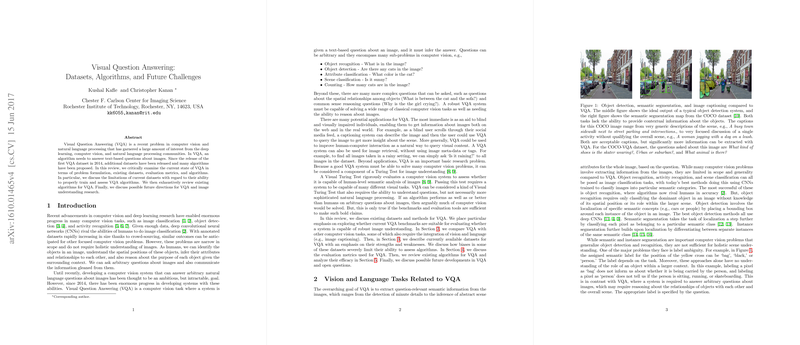Overview of Visual Question Answering in Computer Vision
The paper "Visual Question Answering: Datasets, Algorithms, and Future Challenges" provides a comprehensive review of the field of Visual Question Answering (VQA), an emerging area that bridges computer vision and natural language processing. This task requires an algorithm to answer textual questions based on visual content, posing a significant challenge due to its demand for holistic image understanding and reasoning abilities. The authors, Kushal Kafle and Christopher Kanan, explore various aspects of VQA, including datasets, evaluation metrics, algorithms, and future directions.
Datasets in VQA
The authors survey several major datasets developed for VQA, starting from the pioneering DAQUAR dataset to more recent efforts like Visual Genome and Visual7W. Each dataset has unique characteristics, such as the type of images used (real or synthetic), the nature of the questions (open-ended or multiple-choice), and the method of dataset creation (manual or automated). The review highlights critical challenges such as dataset biases and question diversity that can affect the efficacy of training and evaluating VQA algorithms. For instance, COCO-VQA, a commonly used dataset, shows a strong bias toward certain answers, which can be leveraged by algorithms to gain high accuracy, potentially without robust image understanding.
Evaluation Metrics
Evaluating VQA systems accurately remains a significant challenge, given the variety of acceptable answers to questions. The paper discusses several metrics, such as simple accuracy, a consensus-based approach that uses multiple ground-truth annotations, and modified WUPS. Notable is the use of a consensus-based evaluation in The VQA Dataset, which considers multiple human-provided answers to determine correctness. However, the authors critique these methods for their limitations in capturing semantic similarity and handling multi-word answers, underscoring the need for improved evaluation methodologies.
VQA Algorithms
A plethora of algorithms have been developed to tackle the VQA task, primarily using a classification framework where images and question features are combined and fed into a classifier. The paper categorizes these approaches, highlighting:
- Baseline Models: Simple classifiers combining CNN-extracted image features and LSTM or BOW question representations.
- Bayesian Models: Approaches that model the co-occurrence of image and question features probabilistically.
- Attention Mechanisms: Techniques that model which parts of an image or question are most relevant, greatly popularized in the field for their interpretability and improved performance.
- Bilinear Pooling: Methods that allow for more complex interactions between image and question features.
- Compositional Models: Approaches that break down the VQA task into sub-tasks, reflecting the compositional nature of questions.
Despite the diversity of methods, the paper illustrates that improvements hinge on the model's ability to effectively utilize both visual and textual information while overcoming inherent dataset biases.
Implications and Future Directions
The authors emphasize the need for continued development of VQA datasets that better represent the complexities of real-world tasks and reduce language biases. The advent of models that can not only perform well on biased datasets but excel in generalizing to diverse and balanced question scenarios remains a goal for the field. Furthermore, enhancement in evaluation metrics to accommodate the multimodal nature of VQA challenges prevalent biases and diversifies the types of tasks that a VQA system can handle, pushing towards a more comprehensive visual Turing test equivalent.
In summary, "Visual Question Answering: Datasets, Algorithms, and Future Challenges" serves as a crucial resource for researchers by pinpointing the current state and limitations of VQA, charting a path toward more robust and generalizable image understanding systems.
